Greens
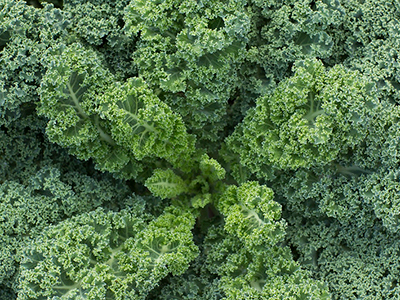
A head of kale, a very popular green. This is only one of the many greens that grow well in Florida vegetable gardens.
Greens are a staple in traditional Southern cooking. However you prepare them, leafy greens are a nutritious addition to your garden and your plate. They are rich in vitamins A, C, E, and K. Greens are a good source of calcium, potassium, folate, and iron, too. They are also high in fiber and low in carbohydrates, sodium, and cholesterol.
If you're looking for an easy addition to your garden, look no further! Greens are making their way into gardening and landscaping beds across the country.
In this article we'll cover six greens that grow happily in our Southern gardens. Our list is by no means exhaustive, however. Less common greens, like dandelion, might deserve space in your garden, too.
Characteristics of Various Greens
Kale, collard, mustard, and turnip greens are all closely related. They belong to the cabbage family, Brassicaceae. Swiss chard and spinach, on the other hand, belong to the goosefoot family, Chenopodiaceae. These last two greens are more closely related to beets. Here is a little more about these six species of greens:
Collard greens (Brassica oleracea var. acephala) – Collards have glossy, blue-green, cabbage-like leaves. The flavor is similar to that of cabbage. Collard leaves are usually deep green. Collard cultivars recommended for Florida: Georgia, Georgia Southern, Top Bunch, and Vates.
Kale (Brassica oleracea var. acephala) - Kale leaves are the same general size as collards. They typically have frilled edges. Some ornamental varieties show colorful combinations of red, white, and green. We have a separate page devoted to kale varieties. Kale cultivars recommended for Florida: Vates Dwarf Blue Curled, Tuscan (lacinato), Winterbor, and Redbor.
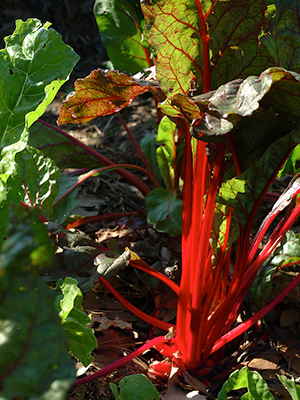
Swiss chard, a delicious and less common garden vegetable. Chard is one of only a few greens that grow well in Florida's warm season.
Mustard greens (Brassica juncea var. crispifolia) – This "green" comes in both green and red cultivars. The texture of the greens are lighter than collards. Mustard's flavor is distinct — peppery and nutty. Mustard cultivars recommended for Florida: Southern Giant Curled, Florida Broad Leaf, Tendergreen, Giant Red, Green Wave, and Mizuna.
Turnip greens (Brassica rapa) – Both the tops and roots of turnips are edible. Its leaves are green and fuzzy. They are similar in texture and flavor to mustard greens. Turnip greens cultivars recommended for Florida: Seven Top and Shogoin
Swiss chard (Beta vulgaris) – Chard's leaves are large, smooth, and beet-like. The leaf color varies from medium to deep green. The midribs can be white, yellow, green, or red. The flavor is milder and the greens more tender than most cabbage-related greens. Chard cultivars recommended for Florida: Bright Lights, Bright Yellow, Fordhook Giant, Lucullus, and Red Ruby.
Spinach (Spinacia oleracea) – Spinach plants are compact and often upright. The edible leaves are glossy and can be eaten raw or cooked. Spinach cultivars recommended for Florida: Melody 3, Bloomsdale Longstanding, Tyee, and Space. Also, see New Zealand and Malibar spinach, discussed below.
Planting and Care
Greens are generally considered cool-season vegetables. This includes spinach, collards, kale, mustard, and turnip greens. In Florida, the season to plant these is August through February. Planting dates vary based on where you are in the state, of course. For more information on planting, we recommend consulting the Florida Vegetable Gardening Guide. It contains valuable information, including planting dates, depth, and spacing.
If the weather is already warming up it is probably too late to plant cool-season crops. But you haven't missed your chance to enjoy home-grown greens this year! Swiss chard can be planted later in the year than most greens. Plant chard as late as May (March in South Florida).
New Zealand spinach and Malabar spinach also grow well during warm months in Florida. If you're planting in the warmer months, consider adding these greens. Neither is a true spinach, but their flavor and texture are similar.
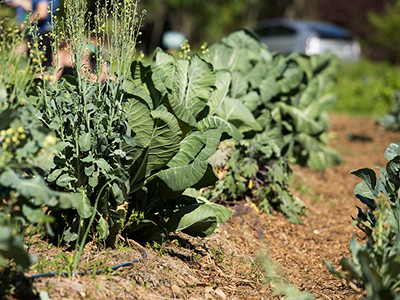
A row of leafy greens at the UF student gardens. Raised rows help control moisture and weed levels.
Once you've chosen your crops and cultivars, you're ready to plant. Raised rows or beds are excellent strategies for a garden of greens. If your soil quality is poor, improve it a couple weeks before planting. You can do this by adding compost or another organic soil amendment. For high yields of quality greens, control the weeds in your beds. This is especially important during the first four to six weeks after planting.
For greens, insects are usually more of a problem than diseases. Collards, kale, mustard, and turnip greens are all very closely related. As a result, they suffer from many of the same pests as cabbage. The insects that do the most damage are often larval forms (caterpillars) of moths and butterflies. Integrated Pest Management (IPM) can help you save your greens. You'll also avoid pesticides that may harm our vulnerable pollinator population.
Harvesting and Cooking
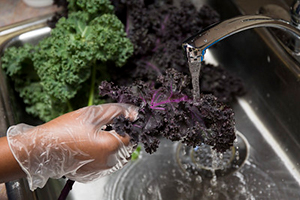
Hand-wash greens before you cook them. This will remove unwanted residue and grit form the garden.
Allow greens to grow undisturbed for six to eight weeks before harvesting. Most should be ready to harvest at around 40-60 days. Plan to harvest kale at about 50-70 days. Collards often take as many as 70-90 days.
When it's time to harvest you can certainly pick the entire plant. You will enjoy a longer harvest, however, by picking leaves a few at a time. Harvest the lower leaves first, as they mature.
Before you cook greens it's important to remove garden grit and pests. Wash freshly harvested leaves with cool, clean water then cool them immediately in the refrigerator. Greens are best when cooked within a day or two of harvest.
There are many ways to enjoy greens.
Kale and spinach can be consumed raw in a salad. Choose the younger, more tender leaves if you prefer a milder flavor. Raw kale can be massaged with oil and spices. This makes it tender without affecting the fresh taste.
You can sauté greens with oil and spices, too, for a bold flavor. Heat a pan over medium heat and add a little olive oil along with the greens. The dish is done when the leaves have taken on a darker color and soften. They will lose much of their volume in the process.
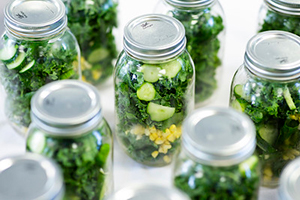
These mason jars are filled with salad mix — one of many creative ways to add home-grown greens to your diet.
For a truly Southern preparation, you can also boil your greens. Simmer chopped greens in a pot with some onion or garlic. Some households add a little apple cider vinegar for flavor. You can save the cooking liquid and dip cornbread in it.
However you enjoy your greens, we can help you get them from the garden to the table. Contact your county Extension office with all of your vegetable gardening questions.
Also on Gardening Solutions
- Cole Crop Confusion
- Cool-season Vegetables
- Heat-tolerant Vegetables
- Kale
- Red Leafy Vegetables
- Swiss Chard
- Vegetable Bolting
UF/IFAS Site: Florida Plant ID
More from UF/IFAS
- Collards, Brassica oleracea L. (Acephala group)
- Dandelion, Taraxacum officinale Weber
- Florida Crop/Pest Management Profile: Cabbage
- Leafy Greens in Hydroponics and Protected Culture for Florida
- Malabar Spinach, Basella rubra
- Mustard Collard, Brassica carinata L.
- New Zealand Spinach, Tetragonia tetragonioides

